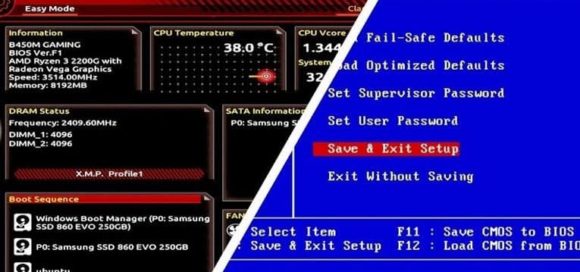
COMPUTER BASIC INPUT/OUTPUT SYSTEM (BIOS)
A computer’s basic input/output system (BIOS) is a program that’s stored in nonvolatile memory such as read-only memory (ROM) or flash memory, making it firmware. The BIOS (sometimes called ROM BIOS) is always the first program that executes when a computer is powered up. In other words BIOS (basic input/output system) is the program a computer’s microprocessor uses to start the computer system after it is powered on. It also manages data flow between the computer’s operating system (OS) and attached devices, such as the hard disk, video adapter, keyboard, mouse and printer.
There are two different types of BIOS:
- UEFI (Unified Extensible Firmware Interface) BIOS – Any modern PC has a UEFI BIOS.
- Legacy BIOS (Basic Input/Output System) – Older motherboards have legacy BIOS firmware for turning on the PC.
CMOS chip:- The BIOS settings are stored in the CMOS chip (which is kept powered up via the battery on the motherboard). That is why the BIOS is reset when you remove the battery and re-attach it. The same program runs, but the settings are defaulted.
UEFI provides faster boot time. UEFI has discrete driver support, while BIOS has drive support stored in its ROM, so updating BIOS firmware is a bit difficult. UEFI offers security like “Secure Boot”, which prevents the computer from booting from unauthorized/unsigned applications.
UEFI is a mini-operating system that sits on top of a computer’s hardware and firmware. Instead of being stored in firmware, as is the BIOS, the UEFI code is stored in the /EFI/ directory in non-volatile memory.
Though UEFI supports the traditional master boot record (MBR) method of hard drive partitioning, it doesn’t stop there. It’s also capable of working with the GUID Partition Table (GPT), which is free of the limitations the MBR places on the number and size of partitions.
UEFI, the successor to Legacy, is currently the mainstream boot mode. Compared with Legacy, UEFI has better programmability, greater scalability, higher performance and higher security. Windows system supports UEFI from Windows 7 and Windows 8 starts to use UEFI by default.
The difference between Unified Extensible Firmware Interface (UEFI) boot and legacy boot is the process that the firmware uses to find the boot target. Legacy boot is the boot process used by basic input/output system (BIOS) firmware.
According to users, you might be able to fix the problem with corrupted BIOS simply by removing the motherboard battery. By removing the battery your BIOS will reset to default and hopefully you’ll be able to fix the problem.
Compared with MBR disk, a GPT disk performs better in the following aspects:
- GPT supports disks larger than 2 TB in size while MBR cannot.
- GPT partitioned disks have redundant primary and backup partition tables for improved partition data structure integrity.
One advantage of GPT disks is that you can have more than four partitions on each disk. … You can change a disk from MBR to GPT partition style as long as the disk contains no partitions or volumes. Before you convert a disk, backup any data on it and close any programs that are accessing the disk.
In summary, it is possible to convert from GPT to MBR without losing data by using command prompt, but you must backup your data first. However, by using AOMEI Partition Assistant you can convert directly between GPT and MBR without deleting the partitions or wiping the drive.
The GUID Partition Table (GPT) is a standard for the layout of partition tables of a physical computer storage device, such as a hard disk drive or solid-state drive, using universally unique identifiers, which are also known as globally unique identifiers (GUIDs).




